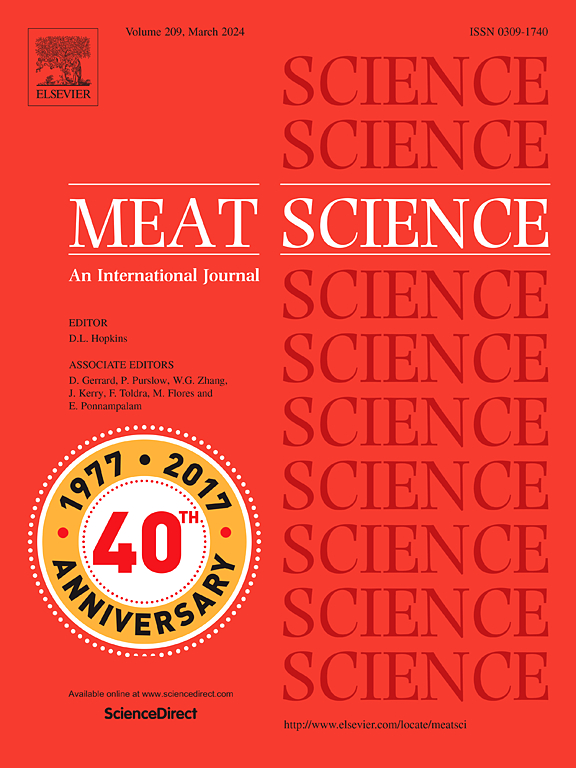The estimation of consumer scores for lamb longissimus lumborum muscle juiciness using pressed juice percentage values
IF 6.1
1区 农林科学
Q1 Agricultural and Biological Sciences
引用次数: 0
Abstract
This study investigated the effects of replication (r) on the pressed juice percentage (PJP) variation of lamb meat and the relationship between PJP and consumer sensory scores for juiciness, tenderness, flavour, and overall liking. Samples were collected from the right longissimus lumborum muscle of 50 lamb carcasses and analysed for PJP as well as eating quality scored by 64 untrained participants of consumer sensory panels. It was found that there was a 19.4 % reduction in variance from 3 additional replicates (r = 4) and there seems to be little practical advantage to exceeding this number of replicates when measuring PJP for lamb meat – except in instances where higher levels of precision are required. The relationship between PJP and lamb meat eating quality was found to be statistically insignificant, although all coefficients were positive; juiciness (0.62 ± 0.37; P = 0.105), tenderness (0.35 ± 0.52; P = 0.498), flavour (0.44 ± 0.34; P = 0.204), and overall liking (0.37 ± 0.41; P = 0.367). These findings will help to inform research into PJP as an objective measure for lamb meat juiciness and other eating quality traits.
用压榨汁百分比值估计羔羊腰最长肌多汁性的消费者得分
本研究探讨了复制(r)对羊肉的压汁率(PJP)变化的影响,以及PJP与消费者对多汁性、嫩度、风味和总体喜欢度的感官评分之间的关系。从50只羔羊尸体的右侧腰最长肌中采集样本,并对64名未经训练的消费者感官小组参与者进行PJP分析和饮食质量评分。结果发现,3个额外的重复(r = 4)减少了19.4%的方差,并且在测量羊肉的PJP时,超过这个重复数似乎没有什么实际优势-除非在需要更高精度的情况下。PJP与羊肉食用品质之间的相关系数均为正,但无统计学意义;多汁性(0.62±0.37;P = 0.105),压痛(0.35±0.52;P = 0.498),风味(0.44±0.34;P = 0.204),总体好感度(0.37±0.41;p = 0.367)。这些发现将有助于将PJP作为羊肉多汁性和其他食用品质特征的客观衡量标准的研究。
本文章由计算机程序翻译,如有差异,请以英文原文为准。
求助全文
约1分钟内获得全文
求助全文
来源期刊

Meat Science
工程技术-食品科技
CiteScore
12.60
自引率
9.90%
发文量
282
审稿时长
60 days
期刊介绍:
The aim of Meat Science is to serve as a suitable platform for the dissemination of interdisciplinary and international knowledge on all factors influencing the properties of meat. While the journal primarily focuses on the flesh of mammals, contributions related to poultry will be considered if they enhance the overall understanding of the relationship between muscle nature and meat quality post mortem. Additionally, papers on large birds (e.g., emus, ostriches) as well as wild-captured mammals and crocodiles will be welcomed.
 求助内容:
求助内容: 应助结果提醒方式:
应助结果提醒方式:


